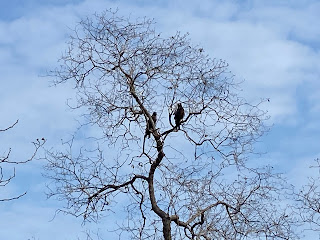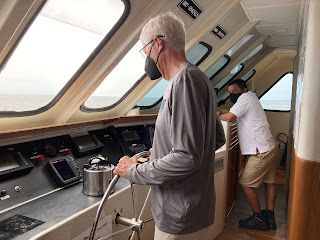Our signal to get out of bed this morning was hearing the anchor drop in Urbina Bay of Isabela Island. We dressed in swimsuits, or had suits on under clothing, After breakfast, we collected our wetsuits and snorkeling gear and made a wet landing on the beach.
The beach was marked by depressions where the giant sea turtles had laid their eggs during the night, and the tracks in the sand where the turtles had returned to the sea. Each turtle lays approximately 120 eggs.
One, or perhaps two, will result in a turtle that reaches sexual maturity and is able to create another generation. Most of the rest will become prey to birds or other animals in the first days or weeks of life.
On our hike, we saw several of the adult turtles feeding on land. Our tour director, Alejandra, pointed out several examples of turtle scat, which demonstrated the differing diets chosen by individuals. We noted that some individuals had been feeding on the Galapagos “poison apples,” a small fruit, sort of like a crabapple, that is highly toxic to most animals, but which the turtles can tolerate. The poison apple trees are so toxic that human skin is painfully irritated even by touching the bark of the tree, so we had to watch out for these trees as we made our way on the trail.
We also encountered a few land iguanas, which look very much like the sea iguanas we saw yesterday, but are the color of sand, rather than the color of the dark gray volcanic rocks, so that each species is well camouflaged in its own environment. These land iguanas also tend to be more solitary, not hanging out together in large groups like their sea-adapted cousins.
Large black bees were buzzing around some of the flowers, and these, too, are a unique species here in the islands. A very large pair of Galapagos hawks kept an eye on us from their perch, high in a tree.
We were scheduled to snorkel from the beach, but Alejandra didn’t like the look of the water conditions. After yesterday’s experience with a couple of people getting into trouble in the rough water, I think she was being extra cautious. So our snorkel gear went unused and the zodiac was called to return us to the boat.
As soon as we were back on board, the boat began heading northwest, along the west coast of Isabela. We relaxed on the sun deck (which on this boat has quite a bit of shade) as the boat motored along. The temperature was very pleasant. We did some reading, but also had a chance to see manta rays leaping from the water. Frigate birds flew around the boat, sometimes swooping by us only a few feet away, or perching on the ship’s radar dome above us.
We arrived at a place called Tagus Cove, along Isabela’s western shore. This is a very protected area in which ships have anchored for the last couple centuries — including Charles Darwin’s HMS Beagle, pirate ships, and whaling vessels.
Because we had skipped the morning snorkeling, was arrived a bit ahead of schedule, and found several other tourist boats anchored here, as well. All but one of them departed shortly after our arrival, but a couple others arrived to take their places. This scheduling is how the national park keeps any one spot from becoming overcrowded.
One evidence of so many sailors having visited here in the past is the presence of a great deal of graffiti on the rock walls above the cove. Most consists of names and dates of the “Kilroy was here” sort. Some are carved into the rock, but most are painted. The earliest is a carving dated 1836 — just one year after Darwin’s visit — which we got to view close up.
At 2 p.m. we had the opportunity to go kayaking in the cove. We have done a fair amount of canoeing, and the two-person kayaks are really not too much different. We had to slow down several times to allow the others to catch up with us, but that gave us extra time to observe the flightless cormorants, the brown pelicans, and the Galapagos penguins who reside in the cove.
A Galapagos penguin on the surface |
At the end of our route, five of us joined Alejandra for some snorkeling, while those who chose not to swim got back into a zodiac and returned to the boat. Mary was among those who opted not to hop into the cold water. Visibility was not particularly good, but we did get to swim with a few penguins who went shooting past us at great speed.
One swimmer became fatigued, and since the conditions were not optimal, Alejandra decided to call time for all of us and signaled the zodiac to come take us out of the water and back to the boat. A warm shower felt very good.
At 4:30 p.m. we set out from the boat in the zodiac once again, this time prepared for a dry landing on the rocks at the end of the cove. As we set out on our hike, this is where we saw the 1836 graffiti, and many others more recent, up close. We climbed a long set of wooden stairs, and from the top had an excellent view of the entire cove.
But the trail continued up the hill, and we were surprised to come to an overlook on the rim of a volcano crater that was on the side of the main cone. The lake at the bottom of the crater is brackish due to seepage from the sea.
The trail continued further with even better views of the crater lake, as well as “incense trees” on hillsides as far as the eye could see. These trees appear to be dead, but snapping off a branch proves that they are green soft, and very much alive. The sap does, indeed, smell like incense. A few trees are beginning to leaf, and the entire forest will do so soon, as the rainy season begins.
The trail extended all the way to the peak, from which we got a spectacular view. The way down was much faster and easier, and we got back to the boat just in time for dinner. The boat got underway immediately for our longest voyage of the trip, back over the northern head of Isabela and on to the island of Santiago.
Immediately following dinner we had a briefing about the following days’ schedule. And after that, Alejandra took us out onto the deck to see something special. One of the volcanoes on Isabela is currently active, and in the far distance we could see the faint orange glow of the eruption reflected against the overcast. It was quite a sight! (But too faint to photograph).
At about 9 p.m. I went to the bridge, where El Capitan allowed me to watch the GPS turn to 0.0.0 as we cross the equator from south to north. We have crossed the equator numerous times on this trip already, so it was really just an excuse to get a look at the bridge once again, this time at night.
The blackness of the view out the window is quite amazing. There is absolute nothingness — on this overcast night, no moon, no stars, no lights on the shores of these uninhabited islands, just the blackest of nights. Like an aircraft pilot flying in full instrument conditions, the captain is completely dependent on his GPS, his radar, and ultimately, the good old fashioned magnetic compass that is mounted just in front of the ship’s wheel.
About 1 a.m. I got up to take care of necessary business, and took a moment to step out onto our balcony. By this time, we had rounded the north end of Isabela and were on our way south once again. That put us near the same erupting volcano, but on the other side and somewhat closer. There was the same orange glow in the clouds, but this time a much larger patch of sky was illuminated.
























































